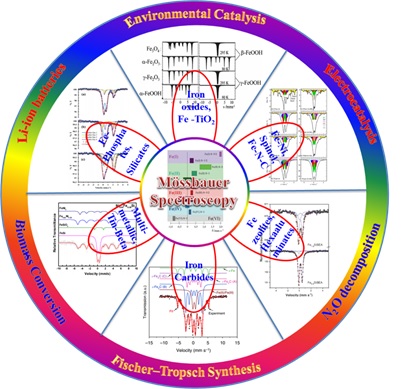Recently,one review from MEDC researchers, entitled as “Unique Role of Mössbauer Spectroscopy in Assessing Structural Features of Heterogeneous Catalysts”, has been published on the journal of Applied Catalysis B: Environmental. 224 (2018) 518-532,https://doi.org/10.1016/j.apcatb.2017.11.004.

Mössbauer spectroscopy, as a powerful technique that can give account of all iron species taking part in the catalysis process, are therefore considered as a crucial tool for determining catalyst phase, identifying active site, and investigating correlations between catalytic behavior and the structure of catalysts, all of these are highly desired for clarifying the catalytic mechanism.
In the past several years, MEDC researchers have made a series of progress in investigating the mechanism of energy and environmental catalysts, by using Mössbauer technique determine the coordination environment, spin state and oxidation state of iron species (Catal. Sci. Technol. 2015, 5, 504-514; Appl. Catal. B 2016, 179, 196-205; Catal. Commun. 2016, 77, 32-36; Appl. Catal. B 2016, 181, 788-799; Catal. Sci. Technol. 2016, 6, 7486-7494; ACS Nano, 10 (2016) 11532–11540 etc.). In DICP, Mössbauer spectroscopy has also been applied into the research fields including in electrocatalysis (Nanoscale, 2016, 8,2333-2342; Chem. Commun. 52 (2016) 11803-11806;J. Mater. Chem. A 17 (2017), 5, 7753-7758; Elect. Acta, 241 (2017) 433-439; ACS Energy Lett., 2017, 2 1654–1660 etc.), biomass conversion (ACS Catal. 6 (2016) 191-201), and high concentration N2O decomposition (J. Phys. Chem. C 116 (2012) 24487-24495; J. Phys. Chem. C 116 (2012) 671-680), etc.
To give a clear understanding of which field is most suitable for a certain Fe/Sn-based catalyst and the best role of the Mössbauer technique in a certain catalysis field associated with the investigation of the mechanism, in this review, the recent advances of applying Mössbauer technique in catalysis were thoroughly summarized, including results from environmental catalysis and energy catalysis. Remarkable cases of study were highlighted and brief insight into applying Mössbauer technique for various Fe/Sn-based materials in their special catalysis field was presented. This review is of great value for the development of Mössbauer spectroscopy in investigating the catalytic mechanism and the structure-activity correlation.
The research work was financially supported by the National Natural Science Foundation of China and the Chinese Academy of Sciences Visiting Professorships for Senior International Scientists. (Text and Imaged by Li Xuning)